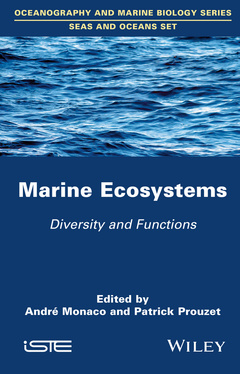Description
Marine Ecosystems
Diversity and Functions
Coordinators: Monaco André, Prouzet Patrick
Language: English
Subject for Marine Ecosystems:
Keywords
beaufort; carbonate; variability; matter; organic; production; biosphere; atmosphere; evolution; planet; importance; biological; compensation; carbonaceous; coupling; productions; life; modification; equilibria; biodiversity; changes
318 p. · 16.5x24.1 cm · Hardback
Description
/li>Contents
/li>Biography
/li>
In a perspective of sustainable management, the balance between ecological dynamics, social and economic are now at the heart of ecological modeling and environmental strategies screenwriting.
Diversity and marine ecosystems function illustrates biodiversity, habitat diversity, structures and food webs in various oceans of the world and systems: pelagic and benthic ecosystems, coral reefs and seagrass beds, oasis of hydrothermal vents ridges or areas rich upwelling.
Appropriate observation methods, long-term monitoring and modeling reveal the complexity of systems, trophic interactions and spatiotemporal dynamics. The ecosystem approach is a prerequisite to assess the state of these systems, their living resources and ecological services involved in local and global environmental changes.
André MARIOTTI and Jean-Charles POMEROL
Chapter 1. Marine Biosphere, Carbonate Systems and the Carbon Cycle 1
Luc BEAUFORT
1.1. Introduction 1
1.2. Marine organisms and carbon 3
1.3. Variability in the production of organic matter 4
1.4. From the biosphere to the atmosphere to climate 7
1.5. Carbonate production 9
1.5.1. Importance of biological carbonate production in the evolution of the planet 10
1.5.2. Carbonate compensation depth 12
1.5.3. Carbonates and climate 15
1.6. The coupling of carbonaceous and organic productions 16
1.7. Modification of equilibria and consequences on marine life 17
1.8. Conclusion 20
1.9. Bibliography 21
Chapter 2. Biodiversity of Phytoplankton: Responses to Environmental Changes in Coastal Zones 25
Tania HERNÁNDEZ-FARIÑAS and Cédric BACHER
2.1. Introduction 25
2.2. Phytoplankton ecology 26
2.2.1. General characteristics 26
2.2.2. Lifecycle 28
2.2.3. Spatial distribution32
2.2.4. Temporal variability and successions 33
2.2.5. Adaptive strategies 35
2.2.6. Functional diversity 40
2.2.7. Ecological niche 42
2.3. Phytoplankton responses to anthropogenic pressures 44
2.3.1. Main sources of anthropogenic variability 45
2.3.2. Responses with regard to biomass, abundance and species composition 48
2.3.3. Changes in spatial distribution 54
2.3.4. Changes in phenology and amplitude of blooms 56
2.3.5. Size spectrum 59
2.4. Observation systems for the identification of phytoplankton 60
2.4.1. Detecting changes in time series 60
2.4.2. Taxonomic aggregation levels 63
2.5. Conclusion 65
2.6. Bibliography 66
Chapter 3. Marine Seagrasses (Magnoliophyta) in the Intertropical Zone 81
Christian HILY
3.1. From plant to habitat 81
3.1.1. Taxonomy and morphology of marine magnoliophyta 81
3.1.2. Biogeography 85
3.1.3. The seagrass habitat 86
3.2. Role of seagrass beds in the coastal environment 87
3.3. Functioning of seagrass beds 89
3.3.1. Production and metabolism 89
3.3.2. Trophic network 90
3.4. Challenges in the conservation of seagrass beds 92
3.4.1. Rare and endangered species 92
3.4.2. Specific role of seagrasses: ichthyofauna of coastal environments 93
3.4.3. Services provided by seagrass beds to humans 95
3.5. Pressures on and threats to seagrasses 95
3.5.1. Cyclones 96
3.5.2. Emersion 96
3.5.3. Global climate change 96
3.5.4. Fishing 97
3.5.5. Boating and water sports 98
3.5.6. The extraction of sandy or coral materials 98
3.5.7. Amenities 98
3.5.8. Terrigenous effluents 98
3.5.9. Harvesting 99
3.6. Restoration of seagrass beds 100
3.7. The functional role of seagrasses in the lagoon ecosystem 101
3.8. Conclusion 103
3.9. Bibliography 104
Chapter 4. Biocomplexity of Coral Ecosystems: Diversity in All its States 107
Michel KULBICKI, Mehdi ADJEROUD, Laure CARASSOU, Pascale CHABANET, Valeriano PARRAVICINI, Dominique PONTON, Fanny HOULBREQUE and Laurent VIGLIOLA
4.1. Introduction 107
4.2. Diversity in the coral world 111
4.2.1. Overview. 112
4.2.2. Diversity of the main constituents of coral reefs 119
4.3. Links between diversities 138
4.3.1. From local to regional 138
4.3.2. From species to function 143
4.4. Conclusion 154
4.5. Bibliography 155
Chapter 5. Man and Diversity in the Coral Environment 165
Michel KULBICKI, Mehdi ADJEROUD, Laure CARASSOU, Pascale CHABANET, Valeriano PARRAVICINI, Dominique PONTON, Fanny HOULBREQUE and Laurent VIGLIOLA
5.1. Introduction 165
5.2. Diversity and ecological services 166
5.2.1. Main ecological services 166
5.2.2. Diversity, robustness, resilience and disturbances 180
5.3. Local versus global threats: what are local threats and what are their effects? 186
5.3.1. Eutrophication 187
5.3.2. Pollution by chemical products and hydrocarbons 189
5.3.3. Impacts of coastal development 190
5.3.4. Coral diseases 191
5.4. What are the combined effects of local and global threats on corals? 192
5.5. Functions and diversity 194
5.5.1. What to protect? 194
5.5.2. Protection means 197
5.6. Conclusion 208
5.6.1. Reefs as a model? 208
5.6.2. Do coral reefs have a future? 209
5.7. Bibliography 210
Chapter 6. Hydrothermal Vents: Oases at Depth 225
Jozée SARRAZIN and Daniel DESBRUYÈRES
6.1. Introduction to deep-sea ecosystems 225
6.2. Discovery of hydrothermal sources 228
6.3. Geology and geochemistry of hydrothermal systems 229
6.3.1. Formation of hydrothermal vents 229
6.3.2. Chemical composition of hydrothermal fluids 232
6.4. Microbial chemosynthesis 233
6.5. Symbioses and trophic chains 236
6.5.1. Symbioses 236
6.5.2. Trophic network 241
6.6. Distribution of fauna at different spatial scales 244
6.6.1. Ridges of the East Pacific 244
6.6.2. Ridges of the Northeast Pacific 245
6.6.3. Mid-Atlantic Ridge 246
6.6.4. Sites in the West Pacific 248
6.6.5. Ridges in the Indian Ocean 250
6.6.6. Ridges in the Southern Ocean 252
6.6.7. Cayman Ridge 253
6.6.8. Biogeography of deep hydrothermal vents 254
6.7. Faunal microdistribution and interactions 255
6.7.1. Environmental conditions 256
6.7.2. Biotic interactions 263
6.8. Temporal dynamics of hydrothermal ecosystems 265
6.8.1. Temporal studies associated with an eruption 266
6.8.2. Temporal studies of active sites 269
6.8.3. Deep-sea observatories 272
6.8.4. Dispersion of larvae and recruitment 273
6.9. Mineral resources and exploitation 275
6.10. Bibliography 279
List of Authors 293
Index 295
Doctor of Science in marine sedimentology and geochemistry, André Monaco is also emeritus research director at the CNRS. He received the first prize of scientific culture of MEN in 1999.
Research Director, Patrick Prouzet took care of the ecosystem approach to the scientific management of Ifremer. In the field of fisheries, he made amphihalin expertise on fish management internationally.




